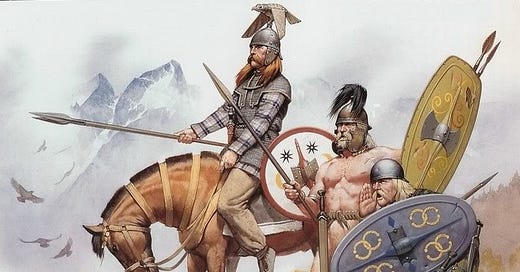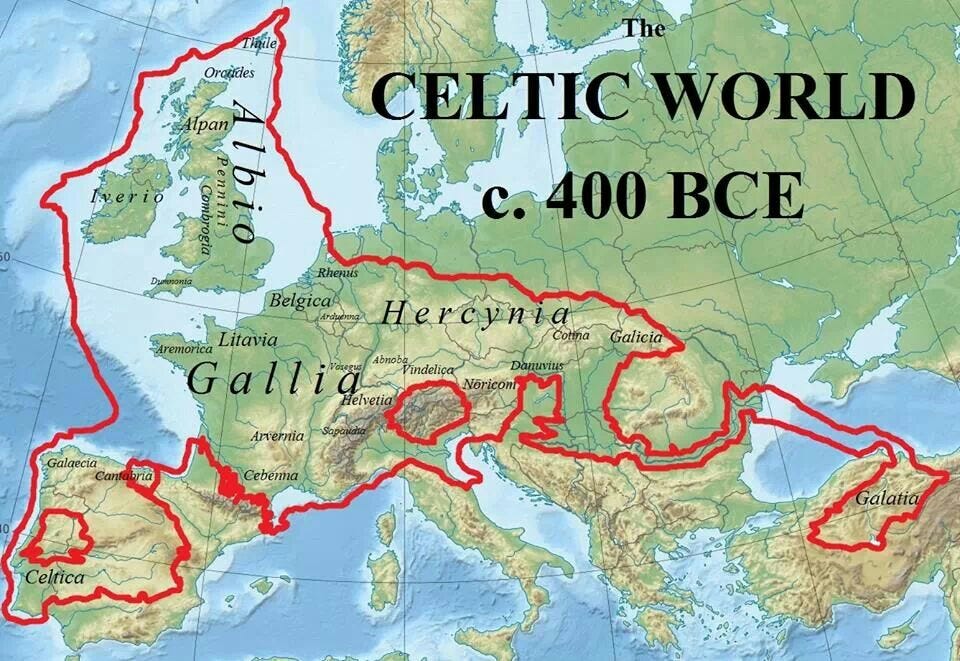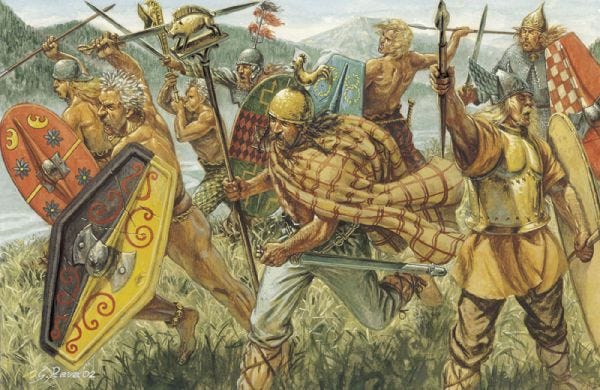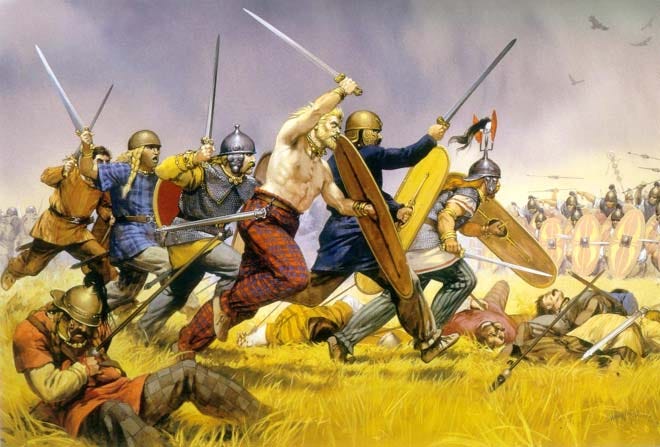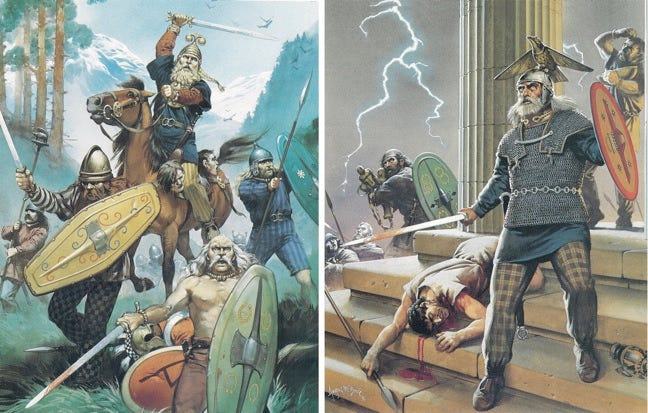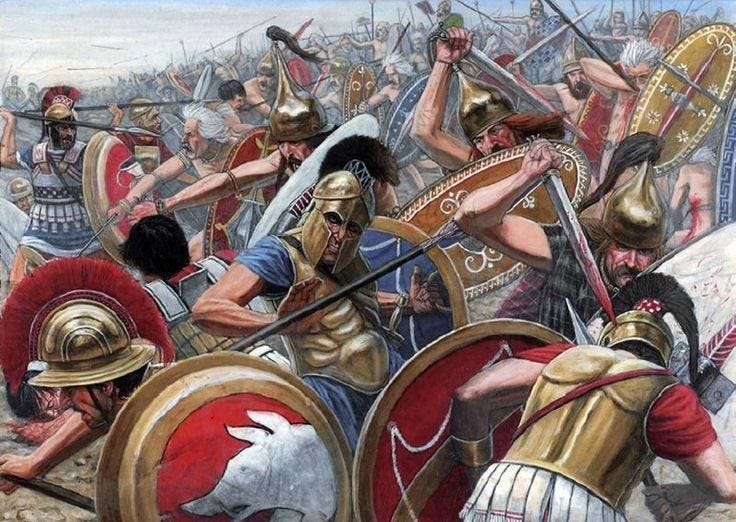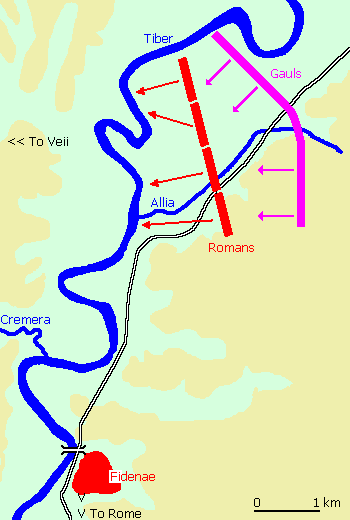The Celts are Coming
Dear Reader,
In this fourth edition of Flint and Steal, we come upon a battlefield littered with the dead. The Romans have overexposed themselves and paid for their mistakes dearly. Today, we will be diving into the Battle of Allia, otherwise known as the First Sack of Rome. So come, dear reader, take a seat around my fire and let’s begin. The Celts will soon march on Rome and we cannot be left behind.
Who is Who?
First and foremost, I need to set something straight. When many people think of the Celts in modern times, they think of the British Isles. In one of the maps below, you can even see areas where Celtic speech is still spoken (Western Scotland and Western Ireland). While it is true that the British Isles house the most direct decedents of ancient Celts and their culture, we must understand that Celts existed throughout all of the ancient world. Their territory was vast and expansive, even before the Romans came. There were many names for the different Celtic tribes and I believe this can be somewhat confusing, especially as people’s borders, and languages have changed throughout time. Below is a map roughly detailing the ancient Celtic world when the Romans first started to gain power. Please also note, dear reader, that this battle would take place when Rome was still a Republic and not an Empire. They were still powerful but more from a regional perspective than a worldly one. Think city state rather than country.
For further context, we must understand that Celts did not just exist in the British Isles but were found throughout Europe and even into Turkey. The Celts were even mentioned in the Bible, as Paul’s Epistle to the Galatians in the New Testament. For the unreligious, this was a letter to the Celts telling them of the works of Jesus. In the map below you can see Galatia in modern day Turkey. The point I am making here is that the Romans would need to deal with Celts, throughout their history as Republic and Empire, and there was no easy way to do it. Also know that, as we delve into this publication, Celts and Gauls are used interchangeably. The Celts were a people that inhabited Gaul and there were many tribes of Celts. Simply know that the Celts (a people), the Gauls (a place), and the Senones (a tribe) are all on the same side.
What it Takes to Win
Let me also set some general context as to how both sides fought. Romans fought with measures of order, and with it being ancient times, this order would have been considered extreme, although very effective. They fought with clear chains of command, with superior weapons, armor, and tactics. Please note, these were not the well ordered lines of the Roman Empire’s Legions quite yet but they were still well organized by any measure. Now, this was in stark comparison to the Celts who fought with basic weapons, unorganized lines, and were often times stark naked.
However, the Celts did have one advantage and that was their use of brutal, vicious, unadulterated force. In ancient times, they were, by far, some of the most feared and revered warriors. Their skills to fight in single combat were second to none. Now, in the few instances, like the Battle of Allia, where the Celts fought with tactics combined with their legendary ferocity, they were simply unstoppable.
The Belligerents
Now, we come to the presentation of arms. One of the belligerent forces in this battle were the Senones (“The Ancient Ones” in Gaulish). These people were the Gallic (Celtic) tribe that had settled in Northern Italy, around Rimini. This tribe was led by a man called Brennus (a mockup of him is seen below). The size of their fighting force, unbeknownst to the Romans, has been estimated to be at somewhere between 30,000-70,000.
The other belligerent forces came from Rome. Now, again dear reader, I must stress that this is not the Rome that we all know and love. These were the days of the early Roman Republic. The Romans were an up and coming power with regional strength. Livy, a Roman historian at that time, had their fighting forces number at around 24,000 men.
Simply Put
Dear reader, we are now quickly approaching the point where the story gets very bloody. However, I must first give further context. See, the Celts and the Romans weren’t always enemies. When the Senones first arrived in Italy, they just wanted somewhere to live, work, and play. As mentioned earlier, they settled in Northern Italy close to Remini. However, Remini is somewhat close to Closium, another ancient city in Italy, and the people of Closium were not thrilled by how close the Celts settled to them. The people in Closium were also not Celts. In essence they felt their presence was a threat, so they called Rome. Again, Rome was not what it would become but they were the largest fish in the pond up to that point. Rome agreed to help Closium and went to talk to the Senones. The Senones agreed to peace if they could have a bit of land. All seemed to be going well right? Wrong.
Unfortunately, during the time of the negotiations there was a brawl in which a Senone Chieftain was killed. What made this worse was apparently some of the Roman Ambassadors had been involved. This was a violation of ancient Negotiating Law as Ambassadors were supposed to stay neutral during arbitration. Understandably, the Celts took this as a great offense but they simply told the Romans that if they handed over the men who had done this, there would be justice done and peace restored.
Unfortunately, for the Celts (and soon to be Romans), the Romans did not want to give up the Ambassadors who had committed the crime. They were Romans on Roman land, they could do no wrong. This would prove to be an incorrect assumption and at the very least, a mistake. However, the Romans figured that they couldn’t just let those Romans Ambassadors live like nothing had happened because the Celts would come after them. So what did the Romans do? Put them in Roman jail for a time? Strip them of lands and titles? Conduct some form of physical punishment upon them? No, dear reader, they did not. See these Ambassadors were part of a high ranking family so the Romans made them untouchable, or at least tried to. They ended up promoting the men who killed the Senone Chieftan to higher military ranks. So high that they were even given “consular powers” or powers that only the head of state has.
Upon hearing that the men who had killed their Chieftain had not been reprimanded but instead promoted, the Celts quickly became enraged. From the Gaulish point of view, they had simply wanted to farm and see justice done but neither had happened. So, they decided to take matters into their own hands but not just against the men who had wronged them, against the state that had wronged them, against all of Rome. So, they began to march.
The Battle of Allia
Dear reader, I cannot understate how one sided this battle ended up being. At no point in time did the Romans ever have the upper hand. First, as previously stated, the Romans had significantly less men and lesser trained men at that. Most battles in history go to the side that has better, and most importantly, more soldiers. The Battle of Allia would prove no different.
To set the stage, as the Romans approached the field on battle, they met the Senones much earlier than they expected to, getting no further than the “eleventh milestone” from Rome. They panicked and hastily readied a defense for the coming Celtic attack. They set up a defensive line, trying to cover an entire valley between a hill and the River Tiber. They also held an additional force of exceptionally poorly trained soldiers in reserve on that hill overlooking the field. Unfortunately for the Romans, this would prove to be the wrong decision. The Romans had too few men to cover the whole valley which meant their lines were thin and overexposed.
When the Celts lined up to face the Romans, Brennus began to see the position the Romans had put themselves in and decided to take advantage of it. Brennus, also in fear of being flanked and wanting the high ground, decided to launch an attack on the hill that held the poorly trained Roman forces. He swiftly defeated them and now focused his attention on the main force of the Romans in the valley below. The Celts had now positioned themselves do strike the killing blow as the Romans had unknowingly positioned themselves into a deadly trap. As seen in the map below, the Romans were now in the low ground in between the Celts and the River Tiber with nowhere to retreat. With his flanks and high ground secured, Brennus sounded the charge and at least 30,000 screaming Celts slammed into the overexposed Roman lines with a swiftness and fury that the Romans had never experienced. When the Roman commanders realized what they had done they tried to retreat across the river but to no avail. The Celts gave no quarter and killed all those who attempted to retreat. Those that did make it to the river drowned due to the weight of their armor or were hounded by Gaulish javelins. The entire army was decimated.
According to Livy, the Roman defeat on the field was so complete that, at first, the Celts did not leave the battlefield. Apparently they were so surprised at their victory that they thought they had fallen into a trap, as they were now in the valley. After some waiting in defensive positions, they began to march again to Rome, the city proper. When they saw the gates open and without defenses ready, they again, thought it was a trap so they took positions outside the walls and set camp for a night. When no attack came, they simply walked into Rome and began to reap the spoils of their victory.
Vae Victis
When Brennus and his forces entered Rome, the subjugation was complete and total. The Celts began to ransack the homes and set fire to them to intimidate those who still stood against them. However, the Celts didn’t burn as many homes as was customarily common for a sack of that time because they were apparently enthralled by the beauty of the city and that they only wanted to intimate those that stood against them. Still, they continued to loot and kill those who offered them any resistance. Brennus was even noted to cry out, “Vae Victus” as his forces secured their victory. This phrase, meaning “Woe to the Vanquished”, would become haunting words to all soldiers of Rome.
There would be a Roman force that would hold out against the Celts on Capitoline Hill. This would anger the Celts and encourage them to put the city under siege. This would lead to the Senones downfall. The siege ended up being good for no one as Rome would fall into strife and other regional powers would come together and create an army under the leadership of the Roman General Camillus. In the end, after failed negotiations, the Senones would be defeated due to their greed and confidence after the Battle of Allia. There is more to this story but that would be another publication. Simply know, dear reader, that after the ill-planned siege, Rome would belong to the Romans again.
The End is Only The Beginning
Now, while the Romans sat their thinking and pondering how this could have happened, they seemed to have all decided that they did not like the taste of defeat. They really did not like it. The taste of their own blood was not something they wanted to taste again (although they would). The Celts had simply come into their home, punched them in the mouth, and they felt powerless. Because of this sacking of Rome (among other battles with Celts), they started to harbor a grudge. No, not a grudge, a blood feud. Throughout the history of the Roman Empire, they would harbor a deep resentment for the Celts, so much so that one could describe their actions later as somewhat genocidal. During the Gallic Wars (58 BC - 50 BC) the Romans would kill over 1,000,000 Celts and enslave another 1,000,000. These may seem like large numbers in today but back in ancient Europe these were percentages of the population.
This persecution would not end until the Empire began to diminish but by then the damage would have been done. The Celtic territories would never again see the strength they once held.
Well, dear reader, it seems that Rome once again belongs to the Romans. I want you to know that I thoroughly enjoyed our time together and that you are always welcome around my fire. Stay tuned for my next publication, where we will be taking a trip to the ancient East.

